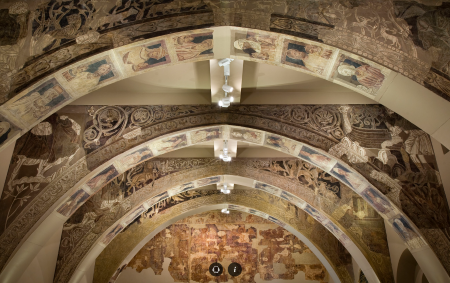Paintings from the Chapter House in Sigena
The mural paintings from the Chapter House of Sigena are a masterpiece of the art produced around the year 1200 and at the same time a unique, most important example of medieval Hispanic art. Sigena was a nunnery, with close links to the Catalan-Aragonese court, founded in 1188 by Queen Sancha of Castile, wife of Alfons II the Chaste.
In 1936, during the Civil War, the Aragonese nunnery was set on fire, the reason why the chapter house’s extraordinary Mudéjar coffered ceiling was lost, while the paintings on the walls were either lost or irretrievably damaged. The perceptible alteration of the original colours, shiny and with a predominance of blues, is the direct consequence of the action of the fire. Only the colour of the last of the four lateral arches leading to the cloister has been minimally preserved, which was saved from the flames as it was blocked up.
In the same year as the fire, and to safeguard them, the paintings were removed by a team of specialists sent from Barcelona, which also took charge of transferring them and their subsequent restoration. In 1940 they entered the museum.
The iconography alternates scenes from the Old and the New Testament in perfect harmony with the architectural setting of the room, combining the themes between the walls and the arches. The episodes from the Old Testament are arranged on the spandrels of the diaphragm arches:
- On the first arch, the scenes of the Creation of Adam and Eve, lost in the fire; on the other side, God shows Paradise to Adam and Eve, and the Original Sin.
- On the second arch, the Expulsion from Paradise and the Angel shows Adam how to work the land; on the other side, the Condemnation to toil and the Offerings of Cain and Abel.
- On the third arch, the Death of Abel at the hands of Cain and Noah building the Ark; on the other side, the Animals entering the Ark and the Return of the dove after the Deluge.
- On the fourth arch, this cycle ends with Noah’s drunkenness, and it is followed by the Sacrifice of Isaac; on the other side the Pharaoh’s army drowned in the Red Sea and Aaron and Moses show the Jewish people the Pillar of Fire.
- On the fifth arch, Moses receives the Tablets of the Law and the Adoration of the Golden Calf; on the other side, Moses brings forth water from the rock in the desert and David is anointed by Samuel.
On the walls of the Chapter House there was a cycle about the life of Christ, of which only the scenes on the south side have been partially preserved, with the depictions of the Flagellation and the Crucifixion and the Visits of the Marys to the Tomb, symbolizing the Resurrection of Christ. The cycle began on the north wall, with scenes of the Nativity, as can be seen in a photograph taken before the 1936 fire. On the intradoses of the arches the series of drawings of the genealogies of Christ appears, which symbolically connects the two Testaments.
From the stylistic point of view, the decoration is of a courtly nature, with a liking for detail, profusion and the heavy feel of the colour, typical of the art of 1200. It has been linked to the mosaics made by Byzantine artists in the Palatine Chapel in Palermo and Monreale Cathedral (Sicily), and also to English miniatures of the period, with which it evidently has points in common. The imaginative and fluid nature of the compositions is outstanding, as well as the ornamental richness of the spaces on the arches left by the scenes, where representations of fantastic beings and floral motifs can be seen.
1196-1208
Conjunt: 589 x 880 x 16.5 cm ; arc: 589 x 880 x 75 cm
Permanent loan from the community of nuns of the Order of Saint John of the monastery of Santa Maria de Sigena, 1940
068703-CJT
















![Pintures de la sala capitular de Sixena [1] Mestre de la sala capitular de Sixena - Pintures de la sala capitular de Sixena - Entre 1196-1208 [1]](https://www.museunacional.cat/sites/default/files/068703-cjt_075217.jpg)
![Pintures de la sala capitular de Sixena [2] Mestre de la sala capitular de Sixena - Pintures de la sala capitular de Sixena - Entre 1196-1208 [2]](https://www.museunacional.cat/sites/default/files/02506001_vista_cap_a_la_natitvitat.jpg)